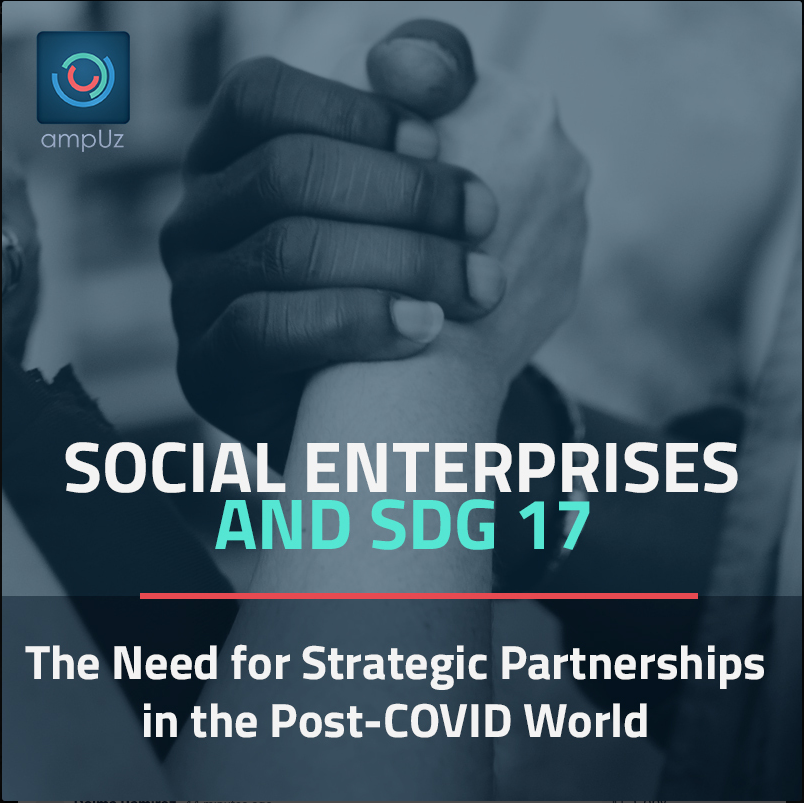
Social Enterprises and SDG 17: The Need for Strategic Partnerships in the Post-COVID World
The United Nations Sustainable Development Goals (SDGs) are indicative of global acceptance that change and impact cannot occur in a vacuum. From their inception which went through one of the most participatory processes in the history of development; to their very nature, which is interdisciplinary and intersectional; the SDGs are dependent on the creation of strategic, and meaningful partnerships.
The commitment to partnerships is so strong it was assigned its own SDG, SDG 17 on partnerships. One of the very first things I tell the social entrepreneurs I work with is that we all play a part in a broader ecosystem, which consists of the private and public sectors, academia, and wider society. To assume that transformative impact can be achieved in a silo is a dangerous trap to fall into. A trap that historically, has severely limited the potential for positive impact for many social entrepreneurs, governments, and corporates.
Good Partnership versus Bad Partnership
While we emphasize the importance of partnerships to create impact, it is essential to note that not all partnerships are equitable. Small-scale social entrepreneurs are often concerned of being “swallowed” by a larger organization with the intention of marketing gain; and hence not authentically aligned with the social entrepreneur’s values, mission, and vision. While bigger organizations doubting the potential for the scale of smaller social businesses.
UN agencies are often reluctant to enter partnerships with the private sector; in many cases, not being able to meet corporate sponsorship visibility requirements. These challenges are valid and stem from a long history of disconnect between private sector intentions, unpredictable on-ground realities, and formalization of reporting in the development sector.
Therefore, with the introduction of more stringent standards around measuring, communicating, and reporting impact, incidental partnerships will be able to move to strategic partnerships.
The data support this notion, a 2016 CEO survey conducted by the UN Global Compact and Accenture, 97% of CEOs believed that greater engagement would depend on better measuring, tracking, and communicating impact. This information represents a massive opportunity for social entrepreneurs to design and implement social impact measurement processes that use the SDG indicators and blend them with their own on-ground experience. As always, impact needs to be created in conjunction with stakeholder perspective, and who better than social entrepreneurs to capture and communicate that impact, while accessing the muscle and reach of UN agencies and bigger private sector players.
The value created through smart, strategic collaboration always outperforms the value created in isolation.
Where are we now?
SDG 17 is crucial for accelerating the progress made across the board, but the trends we are seeing in reaching the target globally by 2030 is worrying. According to the 2019 progress report, the Official Development Assistance to least developed countries fell by 3%; aid to Africa fell by 4%; and the share of least developed countries in world exports remains below 1%.
However, at the end of 2018, more than half of the world’s population had access to the Internet. If this trend continues, this represents a massive opportunity to close the final mile gap, and reach those who were previously unreachable, such as rural women in developing countries.
To demonstrate and strengthen your commitment to achieving Sustainable Development Goals, organizations should take advantage of the Partnerships for SDGs platform, which is open to all stakeholders. Registering on the platform, either as a voluntary commitment or a multi-stakeholder partnership allows organizations to communicate their impact more broadly, while at the same time comparing themselves and their impact with others in the ecosystem. In my view, the strongest point of the platform is maintaining a commitment to collaboration and impact even when the going gets tough. The issue is that participants are invited to self-report on the impact, but hopefully, with more and more stakeholders becoming aware of the importance of impact measurement, that process will become more transparent and standardized.
Solutions such as those offered by ampUz play a crucial role in building the capacities of both small and large organizations to standardize and communicate their indicators and social outcomes.
Post-covid world: An interconnected world
If this pandemic has taught us anything, it is that no man, woman, or country is an island. The global show of solidarity has been inspiring and gives us hope that in the future, strategic collaboration will be the norm rather than the exception. We have realized we are all vulnerable to the same stressors and shocks, and that to reach, and build the resilience of the most marginalized amongst us, we need to use all of the tools and resources at our disposal:
- Social enterprises connections on the ground and understanding of the local context
- Private sectors reach and ability to scale and fund
- Development agency’s experience with project design and stakeholder engagement.
What we are doing at Project Kal is partnering with Ampuz to use and deploy their Gender module to ensure we track our impact and of our partner’s initiatives.
Especially for those often overlooked in development interventions, which is the most marginalized of rural women and girls in rural India, such as waste pickers and sex workers. This partnership is long-term and strategic; as only such partnerships affect the impact bottom line. This is just one of the many examples of new meaningful synergies being created globally, which will inevitably translate into more sustainable and significant impact.
As social entrepreneurs, we are responsible for building the ecosystems around us. Only by creating those ecosystems can we support long-term change and achieve the ambitious 2030 development agenda on time.
